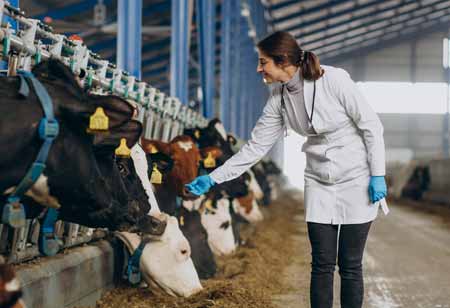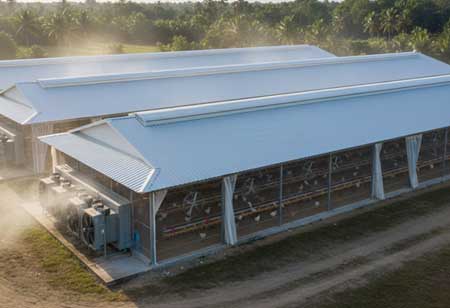Thank you for Subscribing to Agri Business Review Weekly Brief
Diagnostics as the Cornerstone of Herd Resilience in Modern Livestock Production
Herd resilience in livestock production relies on diagnostics for proactive health management, biosecurity, and improved productivity, ensuring sustainable and profitable operations.

By
Agri Business Review | Thursday, September 04, 2025
Stay ahead of the industry with exclusive feature stories on the top companies, expert insights and the latest news delivered straight to your inbox. Subscribe today.
In modern livestock production, the pursuit of herd resilience stands as a cornerstone of sustainable and profitable operations. Resilience, in this context, transcends the mere absence of disease; it embodies the herd's collective capacity to withstand and rapidly recover from health threats, environmental stressors, and production pressures. A resilient herd is a productive and efficient one, consistently meeting performance targets while maintaining a high standard of welfare. Central to cultivating this resilience is a proactive and strategic approach to animal health, with diagnostics serving as the foundation upon which robust biosecurity and enhanced productivity are built.
The integration of advanced diagnostic tools into routine herd management has revolutionized the way producers and veterinarians approach animal health. No longer confined to a reactive posture of treating clinical signs, today's livestock operations can leverage a sophisticated array of diagnostic technologies to anticipate, identify, and mitigate health risks before they escalate into widespread problems. This paradigm shift from treatment to prevention is fundamental to building a truly resilient herd. By providing a precise and timely understanding of the health status of individual animals and the herd as a whole, diagnostics empower producers to make informed decisions that safeguard their livestock and their livelihood.
The Diagnostic Foundation of Robust Biosecurity
Biosecurity is the first line of defense in protecting a herd from the introduction and spread of infectious agents. It encompasses a comprehensive set of management practices designed to minimize the risk of disease transmission. Diagnostics are inextricably linked to the success of any biosecurity program, providing the critical information needed to implement effective and targeted control measures.
One of the primary roles of diagnostics in biosecurity is to surveil and monitor herd health. Regular testing of animals, feed, water, and the environment can detect the presence of pathogens before they cause overt signs of illness. This early warning system enables swift intervention, preventing the establishment and spread of disease within the herd. Whether through traditional laboratory methods or innovative on-farm testing platforms, routine surveillance provides a baseline of the herd's health status, making it easier to identify any deviations that may signal an emerging threat.
The Critical Role of Diagnostics in Biosecurity and Disease Management
Diagnostics are indispensable for the responsible introduction of new animals into a herd. Quarantine and testing protocols are fundamental biosecurity measures, and their efficacy hinges on the accuracy and reliability of the diagnostic tests employed. By screening incoming animals for a range of pathogens, producers can prevent the introduction of new diseases that could have devastating consequences for the existing herd. This proactive approach to managing new additions is a critical control point in maintaining a high-health status herd.
Diagnostics also play a vital role in investigating and managing disease outbreaks, should they occur. Rapid and accurate identification of the causative agent is essential for implementing appropriate treatment and control strategies. Understanding the specific pathogen at play allows for the targeted use of therapeutics, minimizing the development of antimicrobial resistance and ensuring the most effective course of action. Moreover, diagnostic information can help trace the source of an infection, enabling producers to address any biosecurity lapses and prevent future occurrences.
Driving Productivity Through Diagnostic Insights
The link between herd health and productivity is undeniable. Healthy animals are more efficient at converting feed into growth, milk, or fiber, and they are more likely to meet their genetic potential for performance. Diagnostics contribute directly to enhanced productivity by enabling producers to optimize the health and well-being of their animals.
Early detection of subclinical diseases is a prime example of how diagnostics can boost productivity. Many diseases can impact an animal's performance long before they manifest as visible signs of illness. These subclinical infections can lead to reduced feed efficiency, lower growth rates, and decreased reproductive performance. By identifying and addressing these hidden health issues through routine diagnostic screening, producers can unlock the full productive potential of their herd.
Nutritional management is another area where diagnostics can significantly impact productivity. The analysis of blood, milk, or tissue samples can provide valuable insights into the nutritional status of the herd. This information enables the fine-tuning of rations to ensure that animals receive the optimal balance of nutrients for their stage of production. Proper nutrition is not only essential for growth and production but also for a robust immune system, further contributing to the overall resilience of the herd.
Reproductive efficiency is a key driver of profitability in most livestock operations, and diagnostics are instrumental in optimizing reproductive performance. From pregnancy diagnosis to the identification of reproductive pathogens, diagnostic tools provide the information needed to manage breeding programs effectively. Early and accurate pregnancy detection allows for the timely rebreeding of open animals, minimizing non-productive days and maximizing the number of offspring produced per year.
The strategic implementation of diagnostics is not merely an expense but a critical investment in the long-term health, biosecurity, and productivity of a livestock operation. By providing a deep and nuanced understanding of the herd's health status, diagnostics empower producers to move beyond a reactive approach to disease management and embrace a proactive strategy focused on prevention and optimization. In an increasingly competitive and demanding global market, the ability to build and maintain a resilient herd is paramount. Through their integral role in supporting robust biosecurity protocols and driving productivity gains, diagnostics are an indispensable tool in achieving this goal, paving the way for a more sustainable and prosperous future for the livestock industry.





